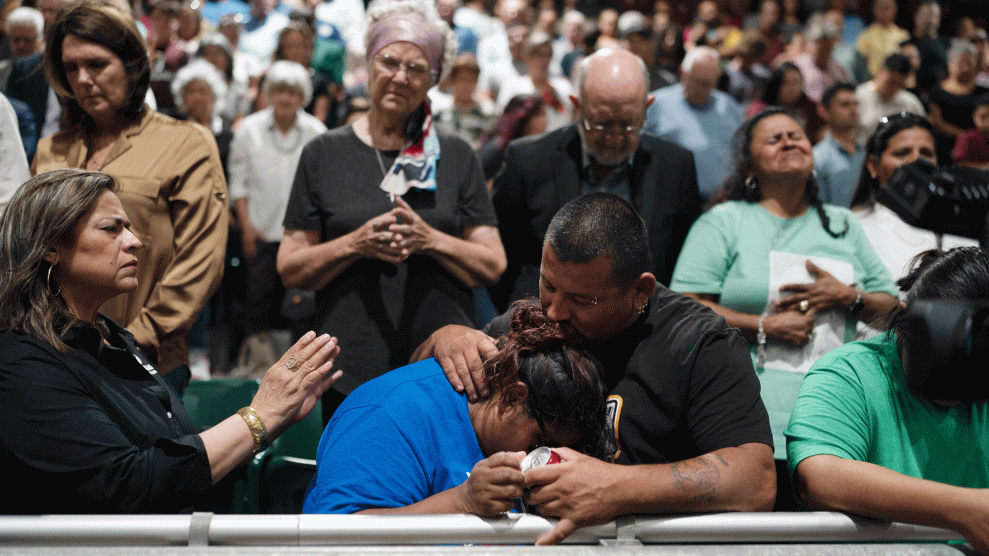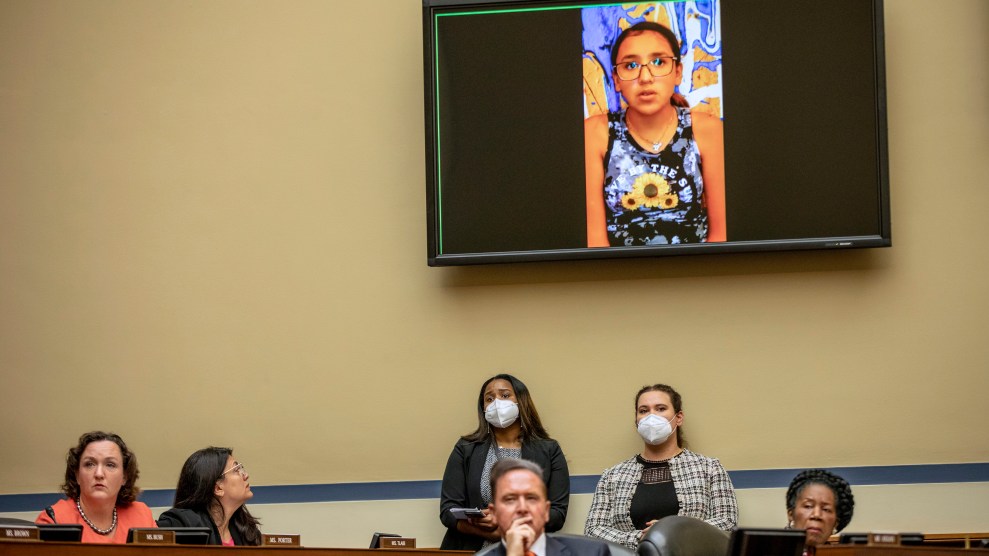
Two family members of one of the victims killed in the shooting at Robb Elementary School comfort each other during a prayer vigil in Uvalde, Texas, on May 25.Jae C. Hong/AP
The 18-year-old gunman who shot and killed 21 people and wounded 17 others at a Uvalde, Texas, elementary school last month was, according to his friends and family, a lonely guy who experimented with self-harm, was bullied for a speech impediment, and engaged in physical fights with his peers. He had asked his sister for help buying a gun. And he had posted vague threats on social media: “Kids,” he said on TikTok, “be scared.”
In other words, he presented the exact kind of behaviors that so-called “red flag” laws are intended to catch before a disturbed person engages in gun violence. Such measures, which provide a legal mechanism to seize weapons from people showing signs of mental duress, are at the core of the bipartisan gun control legislation advancing in the US Senate, which would provide states with funding to enact red flag laws and strengthen existing ones. The bill cleared a procedural hurdle Tuesday night with the support of 14 Republican senators; a cloture vote to limit debate on the bill should occur Thursday.
But even if it passes, federal funding for the bill’s most-discussed provision is unlikely to persuade many of the 30 states that don’t have red flag laws—most of them Republican-led—to adopt them. Some of these states have repeatedly voted down red flag legislation; at least one has formally outlawed their implementation. This means the federal gun control bill, aimed at reining in the epidemic of mass shootings, could have limited impact in a large swath of the country.
Nineteen states and the District of Columbia already have red flag laws. They generally allow community members to report a gun owner displaying concerning conduct to the state’s judicial system, which can then issue an Extreme Risk Protection Order (ERPO) if a judge decides the individual is a risk to themself or others. This allows police officers to temporarily remove guns and ammunition from the gun owner, in the hopes of preventing mass shootings and suicide by firearms.
ERPOs have been effective in preventing both mass shootings and gun-involved suicides in the states that have adopted them: A 2019 case study of California found at least 21 instances in which the orders were invoked to remove guns from people who had threatened mass shootings, including from a high school student who threatened to shoot up a school assembly. Similarly, a 2018 analysis of Indiana’s ERPO law found a 7.5 percent decrease in gun-related suicides in the decade following its passage.
A bipartisan group of 20 senators think such laws could have also been effective in preventing the shooting rampage at Robb Elementary in Uvalde, too. “That is the kind of law that could have made a difference in this case,” Maine Republican Susan Collins said on May 25.
It’s why she and nine other Republican senators joined with 10 Democratic colleagues to come up with a framework for a bipartisan gun control bill that would incentivize states to create red flag laws, provide funds to help states increase access to mental health and suicide prevention programs, ban relationship partners convicted of domestic violence from purchasing guns for five years, expand the background check process for gun buyers aged 18 to 20, and require more types of gun purveyors to officially register as sellers and to require background checks from purchasers.
If the proposed package becomes law, the red flag incentive component would be one of the most significant federal gun violence prevention measures aimed at preventing mass shootings to pass both chambers of Congress in more than 25 years. Over the last few decades, Republican lawmakers and the gun lobby have repeatedly blocked gun control legislation while simultaneously striving to loosen the nation’s gun laws: Case in point is the series of Senate votes after the 2012 Sandy Hook shooting, when a bill requiring states recognize other states’ concealed carry rights got more votes than a bill to expand background checks. (Both bills ultimately failed).
In a deadlocked Congress that has struggled to pass bills to keep kids fed and local governments running, the Uvalde shooting spurred momentum for this package to come together, though it falls short of many Democrats’ goals. The House, with its stronger Democratic majority, was able to pass a slate of gun control measures immediately after the Texas shooting that would have blocked semiautomatic rifle sales to people under the age of 21, created stricter gun storage regulations, and outlawed the sale of magazines holding more than 15 rounds of ammunition. That package stood no chance in the evenly divided Senate, where most bills have to garner the support of at least 60 senators because of the filibuster. An idea to create a national red flag law emerged in the hours immediately following the Uvalde shooting, but Democratic lawmakers saw both logistical challenges to that proposal and political ones.
Thus, optional funding for states to create their own red flag laws seemed like the safest bet to get anything across the finish line with Republicans wary of taking any action on guns, lest they lose their re-elections. Tellingly, several of the GOP senators in the bipartisan Uvalde-response contingent are retiring.
But while the incentive money could be used to help states that already have red flag laws, half a dozen state lawmakers and experts tell Mother Jones it is unlikely federal funding will persuade states that don’t already have red flag laws to create them.
This includes the state where tragedy prompted the bipartisan legislative framework in the first place: Texas. “I don’t believe any federal requirements or incentive would get Texas to move on this,” says Texas state Rep. Diego Bernal, a Democrat in favor of stricter gun control.
He draws a comparison to Texas, joined by 11 other historically red states, opting not to take federal funds in order to expand Medicaid healthcare access to more poor residents: “If we’re not willing to take tremendous amounts of federal money, at no expense to us, in order to insure our uninsured residents, then I don’t see any daylight for financial incentives to get us to adopt a red flag law.”
There is a sharp political divide over red flag laws. Blue states tend to have them. Most red states don’t.
This money isn’t likely to change that map.
Oklahoma, for example, enacted an “anti–red flag law” in 2020 that prohibits the state from enacting such measures or accepting grant money to enact them.
Arizona, Missouri, and Texas have adopted “Second Amendment sanctuary” laws that, in theory, prevent the state from using its resources to comply with federal gun control laws that those states deem unconstitutional. These laws don’t stop the federal government from enforcing its own gun control laws, though a state that has successfully passed a sanctuary city law would be highly unlikely—and perhaps even legally blocked—from passing a red flag law with federal funds.
Texas, for example, passed its Second Amendment sanctuary law after a shooter killed 23 people at an El Paso Walmart in 2019. “It essentially says that any state agency or state actor that attempts to enforce or aid in the enforcement of federal gun control laws will lose their state funding,” explains Bernal. “Not only are you not going to adopt the red flag laws and take the [federal] money, but you’re also essentially prohibited from doing it.”
That doesn’t mean federal funding to support statewide red flag laws would be totally ineffective.
“Regardless if [red states] would or would not be moved by money, this money will help for a number of states who have already enacted these laws to help improve implementation of those laws,” says Allison Anderman, senior counsel at the Giffords Law Center to Prevent Gun Violence.
Several lawmakers who tried to pass red flag laws in majority-Republican states say the proposed federal funding—plus the nonstop mass shootings—motivates them to keep pushing to enact red-flag laws, despite the unlikely odds. Some have learned from previous attempts.
Alaska state Rep. Geran Tarr, a Democrat, for example, introduced a red flag bill after a military veteran from Anchorage with a history of mental illness flew from Alaska to Fort Lauderdale, Florida, with only a checked gun as baggage and proceeded to shoot and kill five people at an airport terminal in 2017.
Tarr says she wouldn’t include a provision allowing “warrantless seizure” of firearms, which is something Indiana’s red flag law permits but the gun lobby decries as unconstitutional, if she introduced a red flag bill again. Tarr also says including a provision that criminalizes filing for an ERPO against an ex-partner purely for revenge may make the legislation more palatable to her pro-gun-rights colleagues.
Former Colorado state lawmaker Cole Wist, then a Republican, also tried to pass a red flag law bill in 2018, after a sheriff’s deputy was shot and killed by a man suffering from mental illness. His bill failed and he was voted out of office, as the gun lobby painted him as a “gun grabber.” (Colorado successfully passed a different red flag law in 2019, when Democrats controlled both chambers of the state legislature again.)
Wist doesn’t think federal incentives will move the needle in Republican-heavy states. “I never heard [costs] as a criticism as to why red flag laws are infeasible. It’s sort of the more traditional argument: that removal of guns from somebody who hasn’t committed a crime is a violation of their constitutional rights,” he says. “I’m not sure how more money really advances the ball on that discussion.”
However, Wist does think red flag laws could be marketed better by gun-control advocates, by depicting them as a tool that can keep police officers protected from disturbed gun owners. “We put law enforcement on the front line of very delicate, very difficult situations,” he says. “I think if law enforcement has a tool like a red flag law to make themselves more safe, they would be supportive of that.”
In Kentucky, state Sen. Morgan McGarvey, a Democrat, has also tried to introduce red flag laws several times. While he says it would be an uphill battle to pass a red flag law in Kentucky, he argues that Senate Minority Leader Mitch McConnell’s verbal support of the bipartisan gun control framework advancing in the Senate indicates progress is possible.
The state ERPO legislation that McGarvey advocates would not only provide affected gun owners with due process to argue before a judge that they are not a threat, but it would also provide people free legal representation to make their case. “This is where federal funds would be hugely helpful,” says McGarvey, who is running for Congress, “because we could use federal funds toward that right to counsel.”
New Hampshire state Rep. Debra Altschiller, a Democrat who introduced a red flag bill in 2019 that passed in both of New Hampshire’s legislature chambers but was ultimately vetoed by the state’s GOP governor, is less optimistic that lawmakers with ardent gun rights beliefs will change their mind. “We had passed a gun-free school zone, and that was also vetoed,” she says. “We passed a [bill for] waiting periods between gun purchase and delivery that was also vetoed. We passed [a bill requiring] background checks for commercial firearm sales that was vetoed.”
Her advice for individuals who want stricter gun control laws in their states is to vote out the politicians who routinely block them.
“We have more mass shootings in America than we have had days on the calendar,” Altschiller says. “If that alone—just for 2022—hasn’t inspired or motivated or moved someone’s heart and mind to recognize the danger in front of them and their constituents, then they have to be voted out.”














